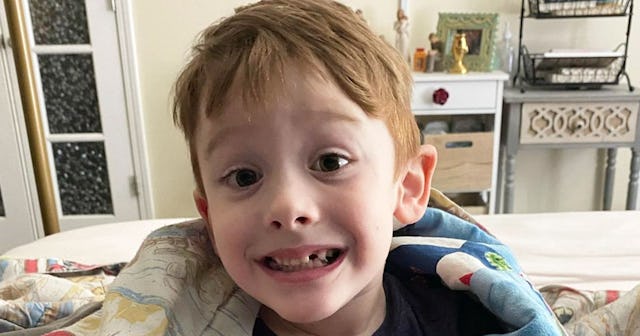Autism Diagnoses Are Up To 1 In 44 — Here's Why I'm So Glad To Hear It

Earlier this month, the CDC announced that the autism rate in the U.S. is currently 1 in 44 children, up from 1 in 54 in 2016. As some other people started to panic, I breathed a sigh of relief. My son, Walker, is part of the 1 in 44, and I am so, so grateful for the expanded diagnostic criteria that allowed him to get his autism diagnosis early so we could support him as he becomes the awesome human being he is working to be.
I knew Walker was autistic from the start. He was always different than my older son, and his particular quirks and challenges screamed autism to me. I had to fight to get him evaluated and diagnosed, but once he was in front of the right experts, my suspicions were quickly confirmed. My boy’s “operating system” was different from most kids, and we would need to figure out how he works.
We’re a few years in now, and we’ve got this. Walker is thriving in school, spending most of his day in a general education classroom, but leaving for small groups and therapies to support his learning. Last week one of his educational assistants described him to me as “a freaking genius,” and I might be biased, but I tend to agree. He is such an incredible little dude.
The thing is, if Walker was born when the diagnostic criteria for autism was stricter, he probably would not be thriving as he is today. That’s why the higher numbers make me happy, not alarmed.
The tests used to diagnose autism are scored. When he was diagnosed at 2, he met criteria. When he was reevaluated by the school system before starting kindergarten, (after a couple years of speech and occupational therapy) he no longer met criteria, even using the current expanded standards. He appears “less autistic” to most people now, but that is not a thing. His autism didn’t disappear; he just learned how to communicate, cooperate and control his body through therapy.
His early diagnosis saved his education. Despite the fact that he doesn’t always meet criteria anymore, his earlier diagnosis combined with his speech delay means that everyone involved recognizes that Walker is, in fact, autistic. He qualifies for all the services and supports that he needs to thrive. Our school district has been a godsend for Walker, never trying to squeeze him into a neurotypical mold. He is free to be his quirky, spunky little self, and they support his education by allowing him the freedom to learn his way.
All of that is because he is 1 in 44.
I know firsthand how important it is for kids to gain access to services as soon as they need them, ideally around age 2. Early diagnosis allowed my son to receive speech and occupational therapies through our health insurance. It gave us a window into how his brain operates so we could make choices about discipline and rewards that made sense to him and didn’t stress him out. We needed that diagnosis in hand so we could access help and make sure we gave Walker what he needed.
My opinion is that a higher rate of diagnosis is wonderful news. It means a lower rate of children struggling because they don’t qualify for the therapies and services they need to support their growth and education.
But you don’t have to take it from me.
I spoke with Karissa Rogers, a K-5 exceptional education lead teacher from Wilson County, Tennessee, about the newly-released autism rate. She agrees that it’s actually really positive.
“The increase in children diagnosed with Autism Spectrum Disorder may increase the number of students qualifying for services in the educational setting,” Rogers explains. “While a diagnosis of ASD is not the only factor used to determine eligibility for services in the school setting, the increase in appropriate assessments allow educators to drive instruction with fidelity and research-based practices.”
Autism is not a tragedy. It’s a vast spectrum of neurological differences. Allowing more of those differences to carry an autism spectrum disorder diagnosis means providing more kids with access to evidence-based interventions– which is a very good thing!
“In my opinion, the continued increase in diagnosis has resulted in higher levels of service, awareness, acceptance, and advocacy for individuals and families,” Rogers continues. “Appropriate interventions within the home and school setting are essential for growth, success, and independence.”
This article was originally published on